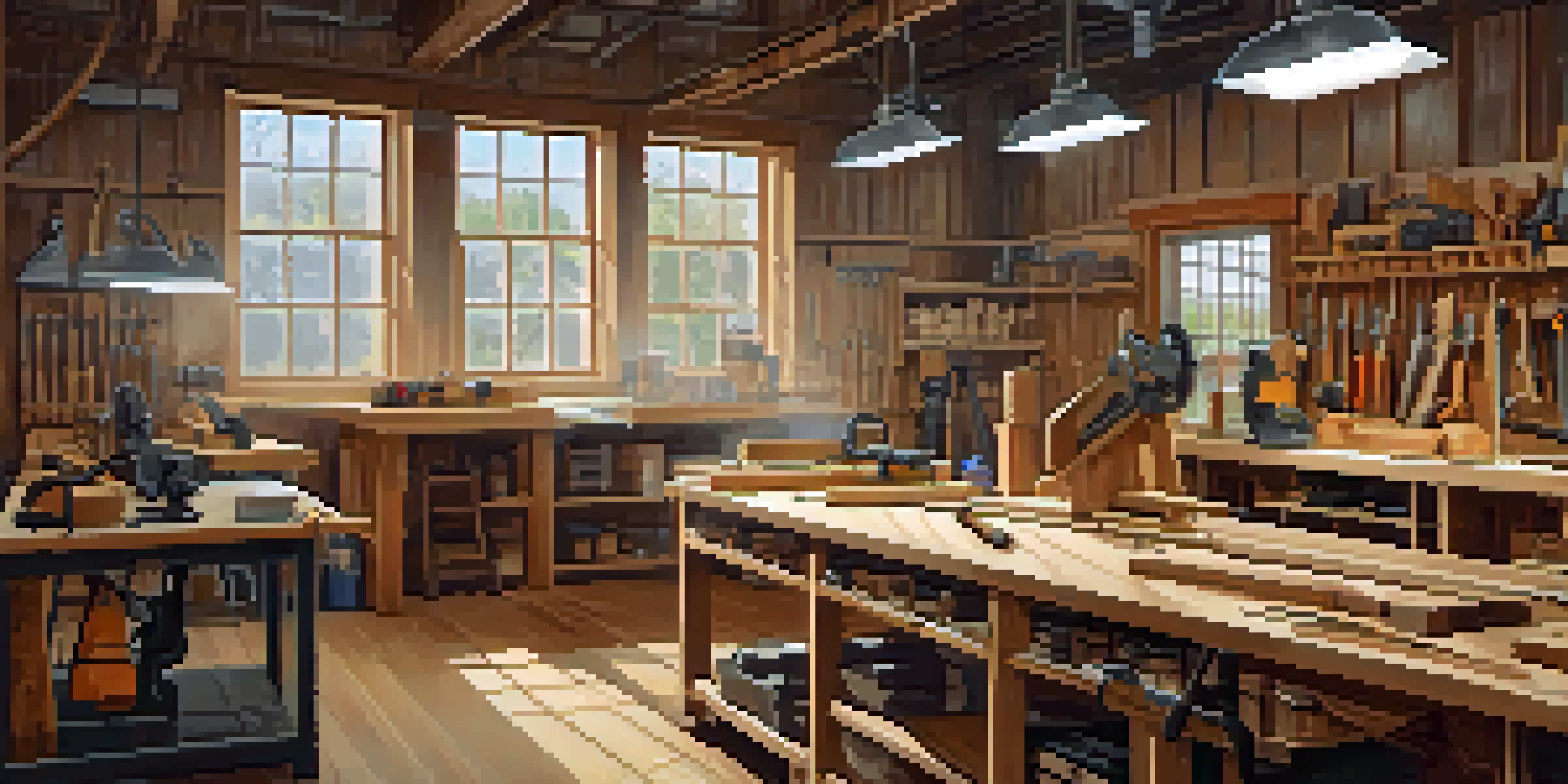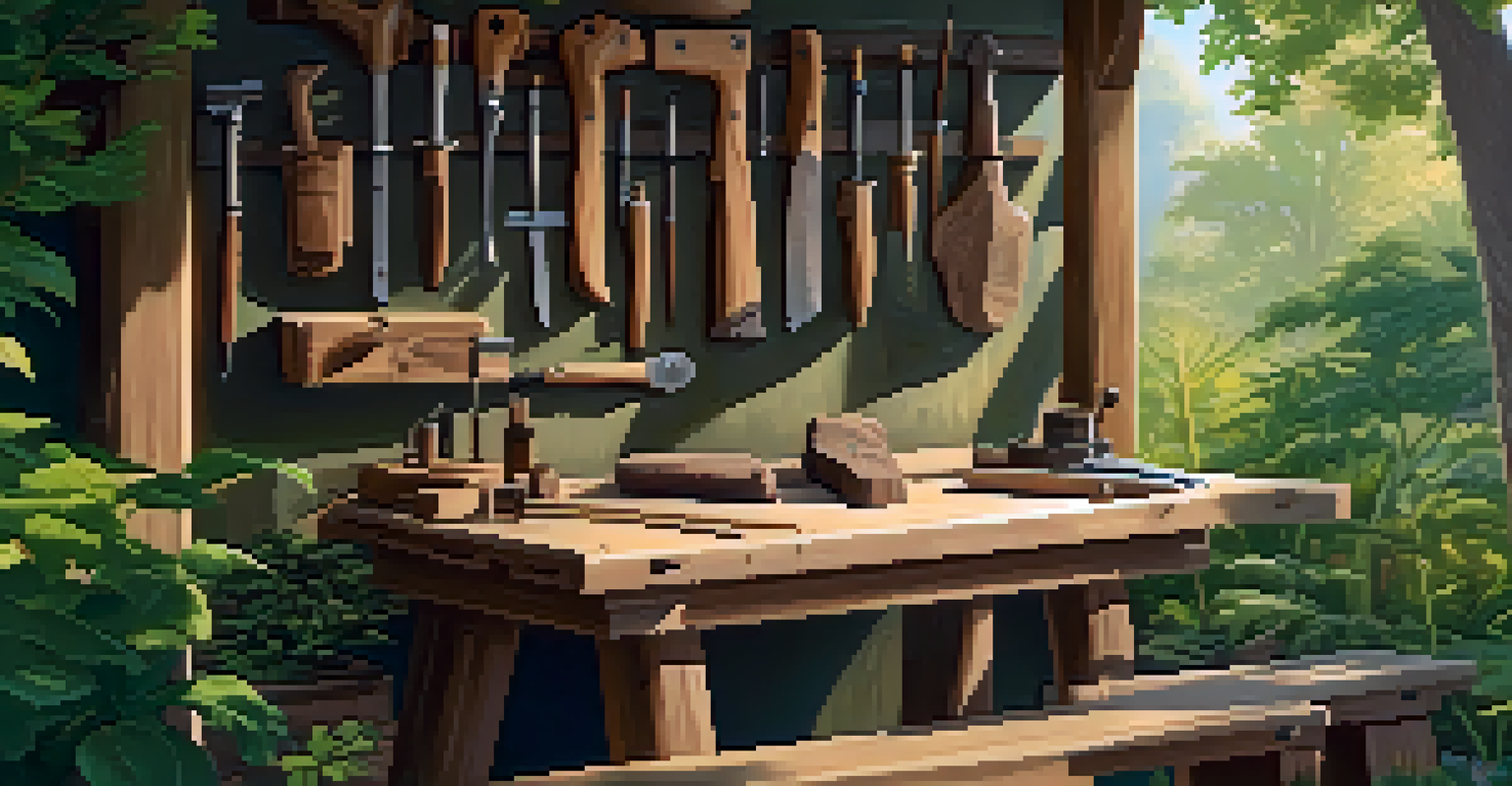Safety Tips for Using Power Tools in Carving Projects

Always Wear Appropriate Personal Protective Equipment (PPE)
When working with power tools, wearing the right personal protective equipment is essential. This includes safety glasses to shield your eyes from flying debris, hearing protection to guard against loud noises, and dust masks to avoid inhaling harmful particles. Remember, your safety should always come first, and PPE is your first line of defense.
Safety isn't just a slogan, it's a way of life.
Consider investing in gloves designed for tool use, as they can provide a good grip while protecting your hands. However, be cautious; some gloves might be too loose and could get caught in the machinery. A snug fit is crucial to ensure they enhance your safety rather than compromise it.
By making the effort to wear PPE, you're not just following safety guidelines; you're also creating a workspace that promotes health and well-being. It can be easy to overlook these small details, but they make a big difference in preventing injuries.
Familiarize Yourself with Your Tools
Before diving into your carving project, take some time to familiarize yourself with each power tool you'll be using. Read the user manual thoroughly, as it contains vital information about the tool's features and safety precautions. Understanding how your tools operate can significantly reduce the risk of accidents.

If you're using a tool for the first time, practice handling it on a scrap piece of material. This will help you get a feel for its weight, control, and potential hazards. It’s much better to make mistakes on scrap wood than on your actual project.
Always Use Personal Protective Equipment
Wearing appropriate PPE, such as safety glasses and gloves, is essential for ensuring your safety while working with power tools.
Remember, knowledge is power. The more you know about your tools, the better equipped you'll be to use them safely. So, don’t rush—take the time to learn, and you’ll find your carving experience much more enjoyable.
Keep Your Work Area Clean and Organized
A cluttered workspace can lead to distractions and accidents, so maintaining a clean and organized area is key. Make sure to remove any unnecessary items from your workbench and keep tools in their designated places. This not only enhances safety but also boosts your efficiency while working on your projects.
The best safety device is a careful worker.
Ensure that your workspace is well-lit, as good visibility can help you spot potential hazards and work more accurately. If you’re working outdoors, pay attention to the weather—wet or windy conditions can create unsafe working environments.
Regularly clean up wood shavings, dust, and other debris that can accumulate during your carving. By taking these simple steps, you can create a safer and more productive workspace, allowing your creativity to flourish without unnecessary risks.
Inspect Tools Before Each Use
Before you start carving, it's crucial to inspect your power tools for any signs of damage or wear. Check cords for frays, blades for dullness, and moving parts for any obstructions. A quick inspection can save you from serious accidents and ensure your tools perform optimally.
If you notice anything out of the ordinary, address it before using the tool. This might mean replacing a worn blade or seeking professional repairs. Taking the time to fix these issues can prevent mishaps that could lead to injuries or damage to your project.
Keep Your Workspace Organized
A clean and well-organized workspace helps prevent accidents and distractions, allowing you to work more efficiently.
Establishing a routine inspection process will help you become more attuned to your tools' condition. This proactive approach not only enhances safety but also prolongs the lifespan of your equipment.
Follow the Manufacturer’s Guidelines
Every power tool comes with a set of manufacturer guidelines designed to ensure safe and effective use. Always adhere to these instructions for the best practices related to your specific tool. Ignoring these guidelines can lead to dangerous situations and potentially void your warranty.
In addition to following the basic operational guidelines, pay attention to the recommended maintenance schedules. Regular upkeep can prevent malfunctions and keep your tools running smoothly, ensuring safety during use.
By respecting the manufacturer's recommendations, you not only protect yourself but also respect the investment you've made in your tools. It's a simple step that can have a profound impact on your safety and success in carving.
Use Tools for Their Intended Purpose
Each power tool is designed for a specific purpose, and using it for anything else can lead to accidents. For example, don't use a jigsaw to cut materials for which it wasn't intended, as this could cause the tool to malfunction or lead to injury. Understanding the capabilities and limitations of your tools is essential.
If you find yourself needing to perform a task that requires a different tool, take the time to switch tools rather than improvising. This extra effort can save you from dangerous situations and ensure that your projects turn out as you envisioned.
Inspect Tools Before Use
Regularly checking power tools for damage or wear can prevent accidents and ensure optimal performance during your projects.
Remember, respect your tools by using them as intended. This not only enhances your safety but also helps you achieve the best results in your carving projects.
Stay Focused and Avoid Distractions
When working with power tools, maintaining focus is paramount. Distractions can lead to mistakes that may result in serious injuries. Whether it’s a buzzing phone or a chatty friend nearby, try to create an environment that allows you to concentrate fully on your carving project.
If you find your mind wandering, take a break to clear your thoughts. It’s better to step away for a moment than to push through while distracted. Your safety and the quality of your work will benefit from a refreshed mindset.

In a world filled with distractions, dedicating your attention to the task at hand can make all the difference. By cultivating a focused work environment, you’re prioritizing both safety and craftsmanship in your carving endeavors.
Know When to Get Help
Sometimes, tackling a carving project can feel overwhelming, especially if you're experimenting with new techniques or tools. Recognizing when to ask for help is a vital safety tip. Whether it’s seeking advice from a more experienced woodworker or getting assistance for heavy lifting, don’t hesitate to reach out.
You can also consider joining a local woodworking group or online forum. These communities can provide invaluable support, tips, and guidance to help you navigate challenges safely. Remember, there’s strength in numbers, and learning from others can enhance your skills.
Ultimately, knowing your limits and seeking help when needed fosters a safer environment for your projects. It encourages collaboration and ensures that you can enjoy your carving experience without unnecessary risks.